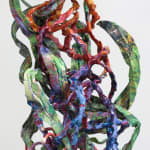




Diana Sofia Lozano
Spiraling in a Carographic Mist (Again), 2025
Steel, resin clay, wool roving,
epoxy resin, aluminum wire,
inkjet print of coca eradication
geospatial data map on cotton
epoxy resin, aluminum wire,
inkjet print of coca eradication
geospatial data map on cotton
44 x 39 x 27 in
111.8 x 99.1 x 68.6 cm
111.8 x 99.1 x 68.6 cm
Copyright The Artist
Further images
In Spiraling in a Cartographic Mist (Again), Diana Sofia Lozano conjures a vegetal form that is equal parts sculpture, data, and resistance. This hybrid organism is inspired by “La Millonaria,”...
In Spiraling in a Cartographic Mist (Again), Diana Sofia Lozano conjures a vegetal form that is equal parts sculpture, data, and resistance. This hybrid organism is inspired by “La Millonaria,” a strain of coca plant known for its mysterious resistance to herbicides deployed by U.S. military operations in South America. At the heart of the sculpture are printed geospatial data maps—tools used to detect and eradicate coca crops—now transposed onto soft, leaf-like forms in cotton. These cartographic overlays are collaged with imagery from U.S. military jungle operation manuals, repurposed into a new visual language that resists the logics of surveillance and extraction.
The sculpture is built from industrial and organic materials—steel, resin, wool, and wire—forming a plant-like structure that appears simultaneously rooted and defensive, fantastical and wounded. In its hybrid form, Lozano evokes camouflage not as concealment, but as strategy: a queer, botanical resistance to regimes of control that seek to flatten complexity.
By incorporating state surveillance imagery into a chimeric, near-mythic structure, Lozano critiques the assumptions that underlie botanical science, militarized cartography, and colonial knowledge systems. The work questions who gets to classify, who gets seen, and what stories are erased in the process. Spiraling in a Cartographic Mist (Again) asks us to look closer—not just at the landscape, but at the systems that shape how we understand it.
The sculpture is built from industrial and organic materials—steel, resin, wool, and wire—forming a plant-like structure that appears simultaneously rooted and defensive, fantastical and wounded. In its hybrid form, Lozano evokes camouflage not as concealment, but as strategy: a queer, botanical resistance to regimes of control that seek to flatten complexity.
By incorporating state surveillance imagery into a chimeric, near-mythic structure, Lozano critiques the assumptions that underlie botanical science, militarized cartography, and colonial knowledge systems. The work questions who gets to classify, who gets seen, and what stories are erased in the process. Spiraling in a Cartographic Mist (Again) asks us to look closer—not just at the landscape, but at the systems that shape how we understand it.





